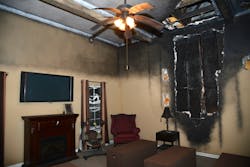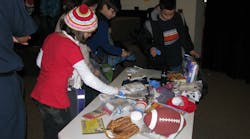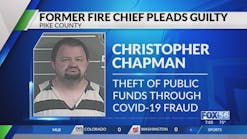Fire and Life Safety are the Focus at Frisco Fire Safety Town
There’s a small neighborhood adjacent to Frisco’s main fire station in North Central Texas that would make fire inspectors and traffic safety specialists happy and Community Education Coordinator Leslie Girdner calls it “Fire Prevention 2.0.”
Girdner oversees Frisco Fire Department’s Frisco Fire Safety Town, which has hosted over 330,000 students since the facility opened 10 years ago. That does not include students from neighboring communities or families who stop at the complex for tours.
Frisco is a fast growing city and the Frisco Independent School District currently has 38 elementary schools with 45,000 students between kindergarten and 12th grade.
Around Fire Safety Town
When tour buses arrive in the area between the fire station and safety town, students are brought into the main lobby, where all sorts of fire equipment is on display. The adults receive background checks via the Raptor system before the group proceeds.
In the hallway to the classrooms, a large photo shows firefighters in the kitchen preparing a meal.
“We want them to experience what it’s like in a fire station, but we don’t want to endanger the students as the firefighters move about their day,” Girdner said.
Two large maps hang in one classroom—one of the U.S. and the other of the world. Pins are used to note where Frisco Fire Safety Town guests have visited from. There are not many areas lacking pins.
“We use a non-classroom style setup,” Girdner said of the facility. Each room has a different seating arrangement. “We are keeping it fresh and we want to keep it so that it's exciting.”
A combination of 18 off-duty firefighters and more than two dozen volunteers—including graduates of the citizen fire academy—teach safety at Frisco Fire Safe ty Town.
“The firefighters, we joke that they drank the Kool-Aid to be over here,” Girdner said. “But all of them, especially the volunteers, have a passion for education.
Apparatus and equipment display area
An impressive feature is an E-ONE quint that was cut down to allow for the apparatus to rest on the floor with the doors at ground level. This allows the children to peer into the cab and compartments without any threats of falls.
The walls surrounding the fire apparatus display the tools of the trade used by firefighters, from PPE to extrication equipment. Displays include a firefighter in a hazmat suit working with a chemical drum, a firefighter climbing a ladder to ventilate a window and a firefighter rappelling off the aerial ladder.
"This allows us to show where tax dollars are going,” Girder said of the display that’s always being updated with equipment.
The living room
One teaching area is a high-tech mockup of a living room that looks like it’s been damaged by fire. Instructors talk about common causes of injury or fire: overload outlets, a science fair project gone wrong, and lightning—a common cause of fires in Texas.
Each lesson includes an entertaining and instructional video that’s been produced by Girdner and her staff and a local video company. The storyline of the incident concludes with talking points and it’s geared towards students and adults as a reminder of common hazards.
The most recent program focused on overloaded outlets and the actors were picked from a local high school drama group.
Girdner said all children can relate to the overloaded outlets scenario because “we are always plugging things in. Our phones, iPads, games, computers…all of our homes have those.” The video covered hazards related to outlets and electricity, and the need to escape and call for help.
The ceiling and one wall of the room have been scorched and ripped apart to expose the charred studs—showing a classic post-overhaul scene. The upper half of the room is covered in soot and the ceiling fan and window blinds are melted, showing the effects of heat.
“When families come in here they learn why we do what we do at fire scenes,” Girdner said. “It's more of a visual for them then talking about why we break open their walls.”
Safety house
Severe weather is a frequent threat to Texans and the Safety House provides both weather home hazards safety and education lessons. The room features a living room, kitchen, bathroom and closet.
The severe weather session starts with children learning about tornadoes, tornado watches and warnings, and other severe weather threats.
The television program that plays during the session is interrupted by a local meteorologist—one who children would be familiar with. “That encourages action,” said Girdner. As the weather broadcast continues, signifying that a tornado is on the ground in the city, the lights begin to flicker and the roaring noise of a tornado plays over speakers.
“It’s all encompassing so that they can feel what a tornado is like,” she said. “We’re hoping that this experience will keep them calm if they do encounter severe weather.”
They learn about FEMA’s recommended duck-and-cover tactic to avoid injuries. A disaster kit is also showcased and firefighters talk about what needs to be in the kit and where to store it. (Click here to read a success story from this program.)
Bedroom
Leaving the safety house, you walk up a set of stairs to a bedroom complete with a bunk bed, furniture and windows. Outside the windows is a mockup of a roof.
Here, students learn how to safely escape from their bedroom during a fire. As theatrical smoke fills the room, they are taught to stay low, how to open a window and then climb through the window to the rooftop below.
“You’ve got to teach them how to open a window during a fire,” Girdner said, noting that many children haven’t opened windows before. “Then they have to learn to throw a pillow out the window so that firefighters see they are trapped.”
"Mini Frisco"
Next to the classrooms is a series of small streets lined with miniature buildings and houses that look like other streets in the city. It’s nicknamed “Mini Frisco.”
“It's as realistic as you can get it on their level. There are street lights, stop signs, crosswalks, railroad tracks…” Girdner said.
Over the years, students return to the village to learn about safety for pedestrians, bicyclists, crosswalks and how to be a good passenger in a vehicle. They ride bikes and ride in vehicles that are equipped with regular seatbelts to learn seatbelt safety.
Lessons by grade
Kindergarten—In their first year at the Fire Safety Town, students learn about 9-1-1 and emergency services. They are taught the proper use of calling 9-1-1 and what they should do when they get an operator on the phone. They also go to Mini Frisco to learn about pedestrian safety and how to use crosswalks.
First grade—Motor vehicle and pedestrian safety are the focus. They learn about safety while riding in cars and proper seatbelt use, followed by roadway safety, reading street signs and how to use crosswalks.
Second grade—This program focuses on fire safety and includes a classroom session, followed by a practical session in the bedroom area. Students are taught about escape routes, the dangers of heat and smoke and then are taught how to escape from a smoke-filled bedroom.
Third grade—Students learn about bicycle safety and pedestrian safety. The class begins with the proper way to fit and wear a bicycle helmet before students ride bicycles around the streets of Safety Town. The group learns about traffic signs, pedestrian safety and bicycle safety.
Fourth grade—The group learns about severe weather and disaster preparedness in fourth grade. Inside the Safety House, students learn how to pack a disaster supply kit and instructors talk about severe weather emergencies, including tornadoes—which are a severe threat in the region. Students experience a simulated tornado and practice the duck-and-cover technique in a closet.
Fifth grade—Safety around the home is the focus of this year’s lesson. Students learn about various household dangers, including safety around cooking, pools and guns, electrical hazards in the kitchen and bathroom and how to use critical-thinking skills.
Sixth grade—The fire department piloted a program for sixth graders for fire safety in school labs. The city currently has 15 middle schools and lab work is a content hazards to students. Students are learning how to use fire extinguishers.
Girdner said Frisco Fire Safety town providers several other programs, including scheduled tours. Several Safety Weekend events are hosted annually and they focus on fire and home safety, along with safety on the streets. Tours are done for Boy and Girl Scout groups and others.
In closing
“Anyone who comes through these doors will be taught about safety,” Girdner said about the scheduled tours. “If the children are too young to understand the lessons, we are getting to the parents.”
At one point, Girdner’s neighbor’s home was damaged by fire. “That experience just opened my eyes to what the fire service can provide,” she recalled.
“Of all the efforts,” Girdner said, “we like to prevent accidents.”










